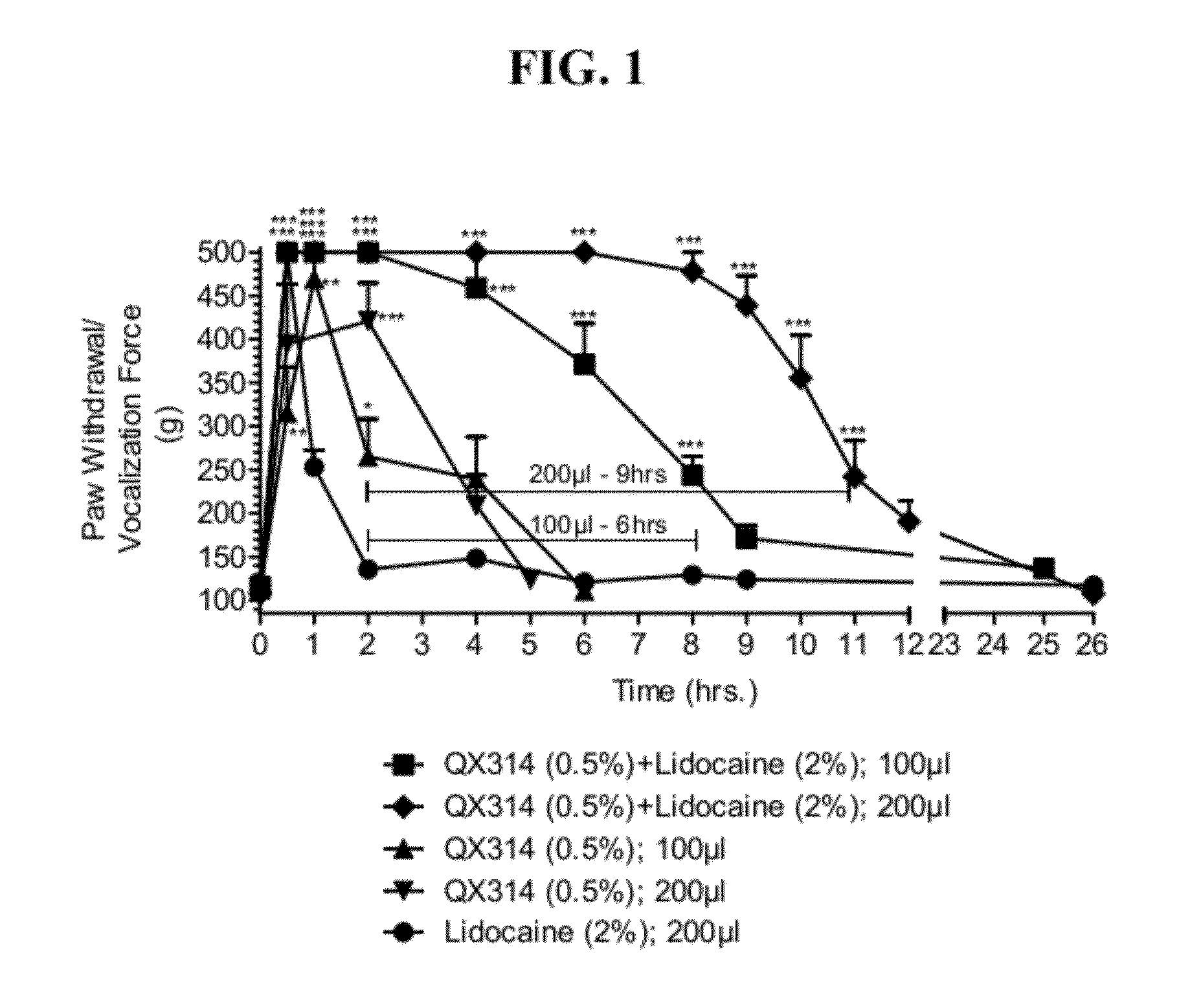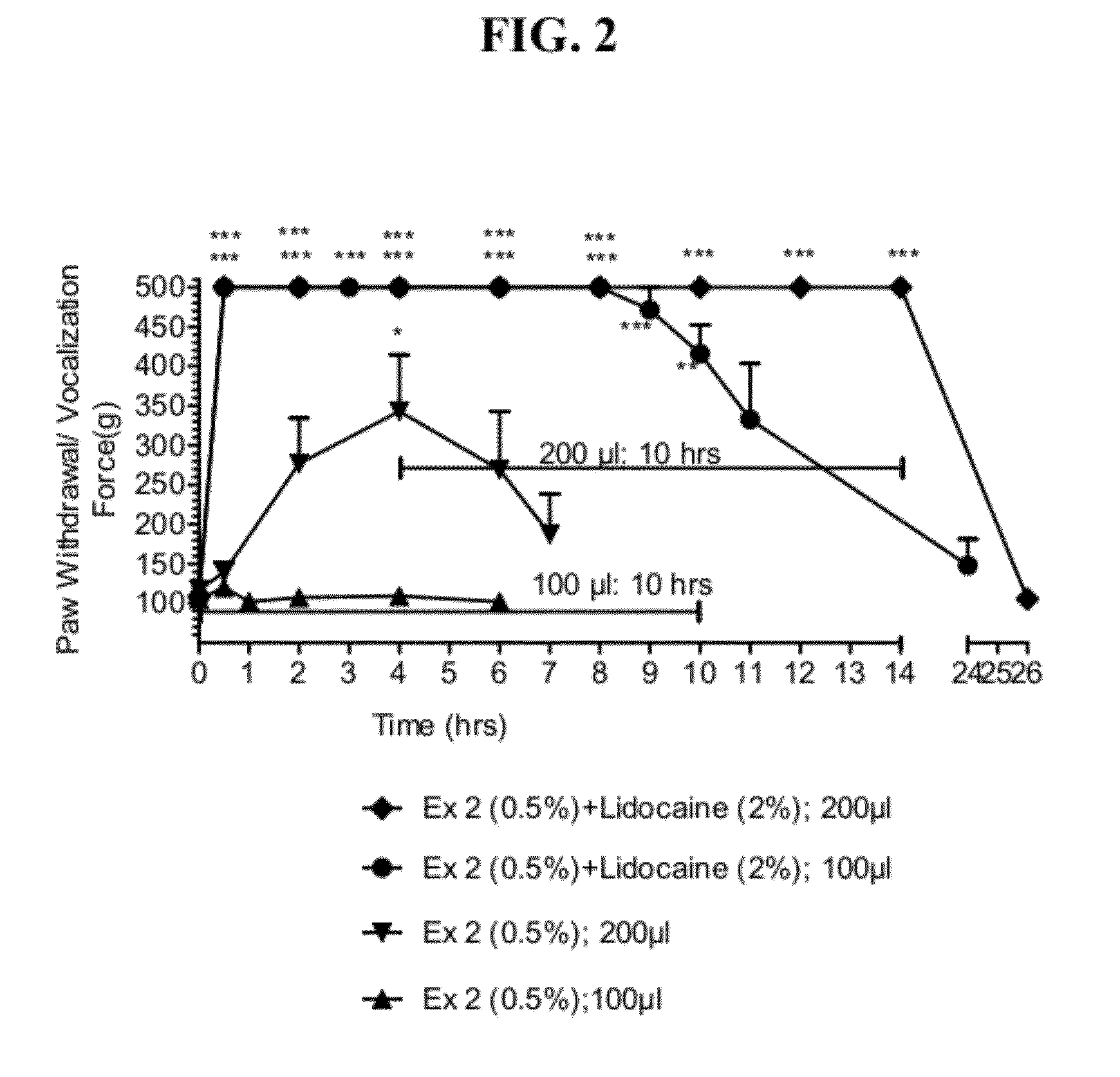Aminoindane compounds and use thereof in treating pain
a technology of aminoindane and compounds, applied in the field of aminoindane compounds and their use in treating pain, can solve problems such as the withdrawal of undesired blockade of motor function
- Summary
- Abstract
- Description
- Claims
- Application Information
AI Technical Summary
Benefits of technology
Problems solved by technology
Method used
Image
Examples
example 1
General Procedure A1—Preparation of (S)-1,1,-dipropyl-2-[2-((indan-2-yl)(phenyl)amino)ethyl]piperidinium iodide
[0498]
A. (S)-2-(Methoxycarbonylmethyl)piperidine-1-carboxylic acid tert-butyl ester (Compound 2)
[0499]To a stirred solution of boc-L-pipecolic acid (1; 15g, 68.10 mmol) in tetrahydrofuran (THF; 175 mL) was added N-methyl morpholine (9.4 mL, 85.12 mmol) at −30° C., followed by the addition of isobutyl chloroformate (9.8 mL, 74.90 mmol) dropwise at −30° C. The resulting mixture was stirred at that temperature for 1 hour. A solution of diazomethane in diethyl ether was then added to the reaction mixture and the mixture was stirred at room temperature (rt) for 16 hours. The reaction mixture was quenched by adding glacial acetic acid (10 mL) and was then concentrated. The residue was dissolved in diethyl ether (500 mL), washed with water (100 mL) and brine (25 mL). The combined organic layers were dried, filtered and concentrated.
[0500]The crude material was dissolved in methano...
example 2
General Procedure A2—Preparation of (S)-1,1-diethyl-2-[2-((indan-2-yl)(phenyl)amino)ethyl]piperidinium iodide
[0534]
[0535]To a stirred mixture of compound 9 (0.15 g, 0.47 mmol) and K2CO3 (0.78 g, 5.63 mmol) in DCE (2 mL) was added ethyl iodide (2 mL) and heated at 65° C. in a sealed tube for 16 hours. The reaction mixture was filtered, washed with MeOH-DCM and concentrated using a rotavapour. The brownish solid crude material was purified using a 230-400 mesh silica gel column chromatograph eluting with 4% MeOH in DCM. The solid material was triturated with ether-hexane to provide (S)-1,1-diethyl-2-[2-((indan-2-yl)(phenyl)amino)-ethyl]piperidinium iodide.
[0536]Yield: 0.17 g (71.62%);
[0537]1H-NMR (400 MHz, DMSO-d6): δ 7.26-7.16 (m, 6H), 6.87 (d, J=8 Hz, 2H), 6.72 (t, J=7 Hz, 1H), 4.68-4.61 (m, 1H), 3.52-3.47 (m, 1H), 3.39-3.16 (m, 9H), 3.04-2.92 (m, 3H), 1.88-1.85 (m, 2H), 1.66-1.47 (m, 6H), 1.19-1.08 (m, 6H);
[0538]LCMS: [M+]=377.8, RT=3.33 minutes;
[0539]HPLC: 97.43%, RT=2.73 minutes,...
example 3
Procedure B1—Preparation of 1,1-dimethyl-2-[((indan-2-yl)(phenyl)amino)methyl]piperidinium iodide
[0541]
A. (1-Benzylpiperidin-2-yl)methanol (compound 13)
[0542]To a stirred solution of piperidine-2-methanol (12; 6 g, 52.09 mmol) in dimethylformamide (DMF, 50 mL) were added successively K2CO3 (10.78 g, 78.14 mmol) and benzyl bromide (6.85 mL, 57.30 mmol) at 0° C. and the mixture stirred at rt for 16 hours. The reaction mixture was then filtered and the filtrate was concentrated. The residue was dissolved in EtOAc and the organic layer was washed with water and brine solution. The organic layer was dried over Na2SO4, filtered and concentrated. The crude material was purified by chromatography on 230-400 mesh silica gel eluting with 30% EtOAc-hexane to provide compound 13.
[0543]Yield: 6.0 g (56.6%);
[0544]1H-NMR (400 MHz, CDCl3): δ 7.37-7.21 (m, 5H), 4.05 (d, J=13 Hz, 1H), 3.85 (dd, J=11, 4 Hz, 1H), 3.50 (dd, J=11, 4 Hz, 1H), 3.30 (d, J=13 Hz, 1H), 2.88-2.83 (m, 1H), 2.69 (brs, 1H), 2.47-...
PUM
| Property | Measurement | Unit |
|---|---|---|
| wear time | aaaaa | aaaaa |
| wear time | aaaaa | aaaaa |
| temperature | aaaaa | aaaaa |
Abstract
Description
Claims
Application Information
 Login to View More
Login to View More - R&D
- Intellectual Property
- Life Sciences
- Materials
- Tech Scout
- Unparalleled Data Quality
- Higher Quality Content
- 60% Fewer Hallucinations
Browse by: Latest US Patents, China's latest patents, Technical Efficacy Thesaurus, Application Domain, Technology Topic, Popular Technical Reports.
© 2025 PatSnap. All rights reserved.Legal|Privacy policy|Modern Slavery Act Transparency Statement|Sitemap|About US| Contact US: help@patsnap.com



